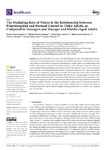Mostrar o rexistro simple do ítem
The Mediating Role of Vision in the Relationship Between Proprioception and Postural Control in Older Adults, as Compared to Teenagers and Younger and Middle-Aged Adults
| dc.contributor.author | Nieto Guisado, Ainhoa | |
| dc.contributor.author | Solana-Tramunt, Mónica | |
| dc.contributor.author | Marco Ahulló, Adrià | |
| dc.contributor.author | Sevilla-Sánchez, Marta | |
| dc.contributor.author | Cabrejas Mata, Cristina | |
| dc.contributor.author | Campos-Rius, Josep | |
| dc.contributor.author | Morales, José | |
| dc.date.accessioned | 2022-01-18T17:08:42Z | |
| dc.date.available | 2022-01-18T17:08:42Z | |
| dc.date.issued | 2022-01-05 | |
| dc.identifier.citation | Citation: Nieto-Guisado, A.; Solana-Tramunt, M.; Marco-Ahulló, A.; Sevilla-Sánchez, M.; Cabrejas, C.; Campos-Rius, J.; Morales, J. The Mediating Role of Vision in the Relationship between Proprioception and Postural Control in Older Adults, as Compared to Teenagers and Younger and Middle-Aged Adults. Healthcare 2022, 10, 103. https://doi.org/10.3390/healthcare10010103 | es_ES |
| dc.identifier.issn | 2227-9032 | |
| dc.identifier.uri | http://hdl.handle.net/2183/29416 | |
| dc.description.abstract | [Abstract] The aim of this study is to analyze the mediating role of vision in the relationship between conscious lower limb proprioception (dominant knee) and bipedal postural control (with eyes open and closed) in older adults, as compared with teenagers, younger adults and middle-aged adults. Methods: The sample consisted of 119 healthy, physically active participants. Postural control was assessed using the bipedal Romberg test with participants’ eyes open and closed on a force platform. Proprioception was measured through the ability to reposition the knee at 45_, measured with the Goniometer Pro application’s goniometer. Results: The results showed an indirect relationship between proprioception and postural control with closed eyes in all age groups; however, vision did not mediate this relationship. Conclusions: Older adults outperformed only teenagers on the balance test. The group of older adults was the only one that did not display differences with regard to certain variables when the test was done with open or closed eyes. It seems that age does not influence performance on proprioception tests. These findings help us to optimize the design of training programs for older adults and suggest that physical exercise is a protective factor against age-related decline. | es_ES |
| dc.description.sponsorship | This research recieved funding from Aristos Campus Mundus 2018 proyect. ID: ACM201803 | |
| dc.language.iso | eng | es_ES |
| dc.publisher | MDPI | es_ES |
| dc.relation.uri | https://doi.org/10.3390/healthcare10010103 | es_ES |
| dc.rights | Atribución 4.0 Internacional | es_ES |
| dc.rights.uri | http://creativecommons.org/licenses/by/4.0/ | * |
| dc.subject | Motor control | es_ES |
| dc.subject | Balance | es_ES |
| dc.subject | Repositioning error | es_ES |
| dc.subject | Injury prevention | es_ES |
| dc.subject | Control motor | es_ES |
| dc.subject | Equilibrio | es_ES |
| dc.subject | Erro de posicionamento | es_ES |
| dc.subject | Prevención do dano | es_ES |
| dc.title | The Mediating Role of Vision in the Relationship Between Proprioception and Postural Control in Older Adults, as Compared to Teenagers and Younger and Middle-Aged Adults | es_ES |
| dc.type | info:eu-repo/semantics/article | es_ES |
| dc.rights.access | info:eu-repo/semantics/openAccess | es_ES |
| UDC.journalTitle | Healthcare | es_ES |
| UDC.volume | 10 | es_ES |
| UDC.issue | 1 | es_ES |
| dc.identifier.doi | 10.3390/healthcare10010103 |
Ficheiros no ítem
Este ítem aparece na(s) seguinte(s) colección(s)
-
GI- ACOM - Artigos [40]






